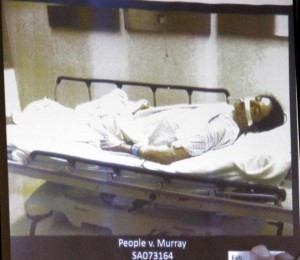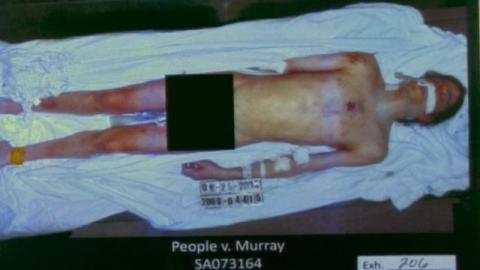World News – Jurors hearing the Michael Jackson wrongful death trial got a stark look at the dead pop icon after a lawyer showed them an autopsy photo. Jackson’s unclothed corpse lying on a coroner’s table looked nothing like the world’s most famous entertainer.
 The doctor who conducted Jackson’s autopsy will return to the witness stand Wednesday. On Tuesday, jurors are hearing from another doctor in the trial to decide whether concert promoter AEG Live shares blame in Jackson’s death with Dr. Conrad Murray.
The doctor who conducted Jackson’s autopsy will return to the witness stand Wednesday. On Tuesday, jurors are hearing from another doctor in the trial to decide whether concert promoter AEG Live shares blame in Jackson’s death with Dr. Conrad Murray.
The witness on the stand Tuesday is cardiologist Dr. Daniel Wohlgelernter, who is offering expert analysis of Murray’s skills and decisions.
Murray was not the “appropriate physician” for AEG to hire as Jackson’s tour doctor because he was a cardiologist and not trained to treat the singer’s special needs, Wohlgelernter testified.
“Michael Jackson had a history of substance abuse, addiction to medications and sleep disturbance,” he said, not heart or cardiovascular problems.
Murray’s agreement to close down his Las Vegas clinic to work full time for Jackson created a conflict, he said. The agreement said Murray could lose his job if the tour was delayed or canceled.
“It meant that Dr. Murray was entirely dependent on the continuation of the tour for his income,” he said.
Much of what jurors heard for the first time from Dr. Christopher Rogers Monday is a repeat of the scientific evidence presented in the trial of Murray, who is now serving a prison sentence for involuntary manslaughter. But some of what is in the coroner’s report seems to give more insight into Michael Jackson’s life rather than how he died.
Rogers noted in his autopsy report that Jackson’s lips were tattooed pink, while his eyebrows were a dark tattoo. The front of his scalp was also tattooed black, apparently to blend his hairline in with the wigs he wore.
The autopsy confirmed what Jackson told people who questioned why his skin tone became lighter in the 1980s. Jackson had “vitiligo, a skin pigmentation disease,” Rogers said. “So, some areas of the skin appear light and others appear dark.”
Jackson lawyer Michael Koskoff made sure the jury heard that, even though it had nothing to do with how he died.
Jackson’s mother and three children are suing AEG Live, contending the company that was promoting his “This Is It” shows was liable for his death because of the negligent hiring, retention and supervision of Murray.
AEG Live argues that Jackson chose Murray as his tour doctor and that the company had no way of knowing he was using the surgical anesthetic propofol to put the singer to sleep each night.
Rogers concluded that a propofol overdose killed Jackson, although several sedatives Murray gave him that morning contributed to his death.
Los Angeles coroner’s toxicologist Dan Anderson, who studied the drugs in Jackson’s body, testified Monday that the level of propofol found in Jackson’s body was “consistent with major surgery anesthesia.”
Propofol is a dangerous drug when not used properly, he said.
The Los Angeles coroner’s office found 31 deaths in the last 14 years in which propofol was found in a body, including six suicides committed by medical personnel — doctors, nurses and anesthesiologists — who chose the drug to end their lives, Anderson said.
There have also been several homicides with propofol, including “a mercy killing” in a hospital, he testified.
If not for his death by propofol, Jackson’s health appeared good enough for him to live a normal lifespan, Rogers testified.
“There was no indication from the autopsy that there was anything anatomically wrong with him that would lead to premature death,” Rogers said.
He had no signs of being addicted to street drugs, such as needle marks or disease, he said.
That testimony is important for the Jackson case, because if the jury decides that AEG is liable in his death, his expected lifespan will be key to calculating damages. Jackson lawyers will contend that he would have made billions of dollars in his remaining years through several more world tours, merchandizing, recording and movies.
By Alan Duke, CNN

